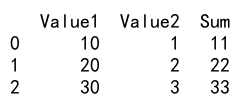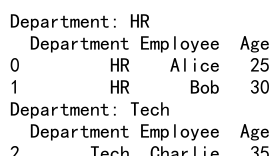Iterate Through Pandas DataFrame
Iterating through a Pandas DataFrame is a common task in data analysis and manipulation. This article will explore various methods to iterate through a DataFrame using the Python library Pandas. We will cover basic iteration techniques, performance considerations, and provide practical examples to demonstrate each method.
1. Using iterrows()
The iterrows() function is one of the simplest ways to iterate over DataFrame rows. It returns an iterator yielding index and Series for each row.
Example 1: Basic Usage of iterrows()
import pandas as pd
# Create a sample DataFrame
data = {'Name': ['Alice', 'Bob', 'Charlie'], 'Age': [25, 30, 35]}
df = pd.DataFrame(data)
# Iterate using iterrows()
for index, row in df.iterrows():
print(f"Index: {index}, Name: {row['Name']}, Age: {row['Age']}")
Output:

2. Using itertuples()
The itertuples() method returns an iterator yielding namedtuples of the rows. This method is generally faster than iterrows().
Example 2: Basic Usage of itertuples()
import pandas as pd
# Create a sample DataFrame
data = {'Name': ['Alice', 'Bob', 'Charlie'], 'Age': [25, 30, 35]}
df = pd.DataFrame(data)
# Iterate using itertuples()
for row in df.itertuples():
print(f"Index: {row.Index}, Name: {row.Name}, Age: {row.Age}")
Output:

3. Using apply()
The apply() function can be used to apply a function along an axis of the DataFrame.
Example 3: Using apply() to Iterate Over Rows
import pandas as pd
# Create a sample DataFrame
data = {'Name': ['Alice', 'Bob', 'Charlie'], 'Age': [25, 30, 35]}
df = pd.DataFrame(data)
# Define a simple function to use with apply
def print_row(row):
print(f"Name: {row['Name']}, Age: {row['Age']}")
# Apply the function
df.apply(print_row, axis=1)
Output:

4. Vectorized Operations
Instead of iterating through rows, using vectorized operations can be much more efficient.
Example 4: Vectorized Addition
import pandas as pd
# Create a sample DataFrame
data = {'Value1': [10, 20, 30], 'Value2': [1, 2, 3]}
df = pd.DataFrame(data)
# Perform vectorized addition
df['Sum'] = df['Value1'] + df['Value2']
print(df)
Output:

5. Using query()
The query() method allows you to filter rows based on a query expression.
Example 5: Using query() to Filter Data
import pandas as pd
# Create a sample DataFrame
data = {'Name': ['Alice', 'Bob', 'Charlie'], 'Age': [25, 30, 35]}
df = pd.DataFrame(data)
# Filter using query
result = df.query("Age > 30")
print(result)
Output:

6. Using groupby()
Grouping data and then iterating over each group is a common pattern in data analysis.
Example 6: Group By and Iterate
import pandas as pd
# Create a sample DataFrame
data = {'Department': ['HR', 'HR', 'Tech'], 'Employee': ['Alice', 'Bob', 'Charlie'], 'Age': [25, 30, 35]}
df = pd.DataFrame(data)
# Group by department
grouped = df.groupby('Department')
# Iterate over each group
for name, group in grouped:
print(f"Department: {name}")
print(group)
Output:

7. Using merge()
Merging DataFrames is a common operation before iteration to bring related data together.
Example 7: Merge DataFrames and Iterate
import pandas as pd
# Create two sample DataFrames
data1 = {'ID': [1, 2, 3], 'Name': ['Alice', 'Bob', 'Charlie']}
data2 = {'ID': [1, 2, 4], 'Age': [25, 30, 40]}
df1 = pd.DataFrame(data1)
df2 = pd.DataFrame(data2)
# Merge DataFrames
merged_df = pd.merge(df1, df2, on='ID', how='inner')
# Iterate over the merged DataFrame
for index, row in merged_df.iterrows():
print(f"ID: {row['ID']}, Name: {row['Name']}, Age: {row['Age']}")
Output:

8. Using concat()
Concatenation is another technique to combine DataFrames before iterating.
Example 8: Concatenate DataFrames
import pandas as pd
# Create two sample DataFrames
data1 = {'Name': ['Alice', 'Bob']}
data2 = {'Age': [25, 30]}
df1 = pd.DataFrame(data1)
df2 = pd.DataFrame(data2)
# Concatenate DataFrames
concatenated_df = pd.concat([df1, df2], axis=1)
# Iterate over the concatenated DataFrame
for index, row in concatenated_df.iterrows():
print(f"Name: {row['Name']}, Age: {row['Age']}")
Output:

Iterate Through Pandas DataFrame Conclusion
Iterating through a Pandas DataFrame can be achieved through various methods, each suitable for different scenarios and performance needs. Using methods like iterrows(), itertuples(), and vectorized operations can significantly affect the efficiency of your data processing tasks. Always consider the size of your data and the complexity of operations when choosing an iteration method.
 Pandas Dataframe
Pandas Dataframe